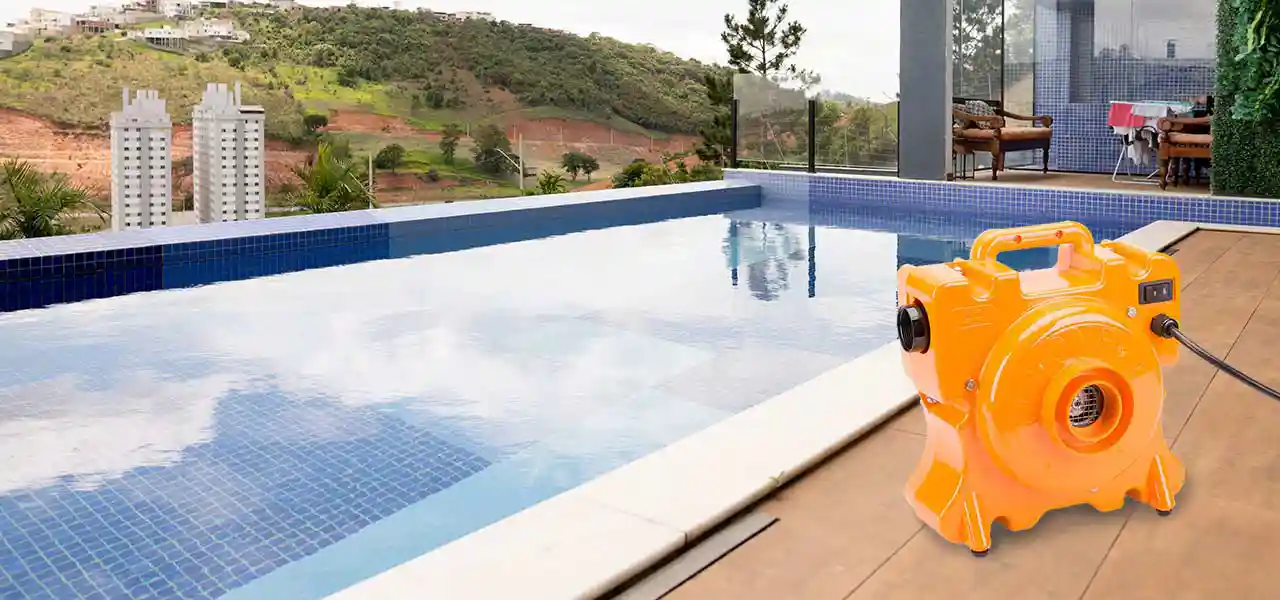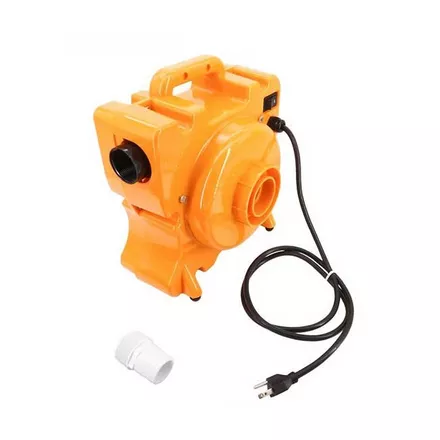FREE Standard Shipping On All Orders $100 or More!*

How to Blow Out Pool Lines for Winter
Back when I had a pool service company, we had a few customers we saw only once per year. These were very hands-on, DIY clients who would have their pool completely closed, and called us out for our blow-only service to winterize the underground lines.
Blowing out the lines is not too complicated. Truly, anyone can do it with the right equipment.
The right equipment for the job, in this instance, is the Cyclone Pool Blower. A suitable substitute to purge pool lines would be the Mighty Vac 2-in-1 Blower and Vacuum.
Common Questions About Pool Plumbing Winterization:
Can You Blow Out Pool Lines Using an Air Compressor?

Yes, you could use a suitable compressor to blow out pool lines, but the potential exists to over-pressurize your pipes and fittings with a compressor. Compressors are high air pressure, low air flow. Cyclone pool line blowers, on the other hand, have low and consistent pressure, with a great deal more air volume. For more details, check out this video where Rox Cox explains How to Use an Air Compressor to Blow Out Pool Lines.
Can You Blow Out Pool Lines Using a Shop Vac?
Maybe. Large canister types of 5 HP or more should be able to handle the resistance of the water. Some wet/dry vacs will release excess air pressure under heavy resistance, but may still be able to blow out skimmers and return lines. The biggest problem is that most wet/dry vacs won't blow out a main drain line. The same is true for many air compressors.
Can You Blow Out Pool Lines Using a Leaf Blower?
It seems logical that it could work. HOWEVER, I've tried it in a pinch with fairly powerful gas-powered leaf blowers. We had fun, used a LOT of duct tape, but had very little success. It may work for shallow skimmer and return lines after lowering the water level. But don't expect great results for more demanding jobs.
The Best Solution?
The Cyclone Pool Line Blower will blow main drains without even having to lower the pool water level. You'll have no problem with deep lines, small lines, or even large lines. Cyclone air blowers are also portable, as well as durable and easy to use. Did you know that Cyclone air blowers can also be used as a vacuum to set pool liners? Come to think of it, you could use the Cyclone to blow out lawn sprinkler systems, too!
So, let's assume that we are using the Cyclone Pool Blower to blow out our pool plumbing lines, shall we?
Preparation To Blow Out the Pool Lines
- Lower the water level 4-12" below skimmer, depending on your pool cover type.
- Remove filter, pump, and heater drain plugs to drain water. Replace loosely.
- Drain, hand pump, or scoop water out of the skimmer(s) until almost empty.
- Set the multiport valve to "Recirculate," or to the "Filter" position for slide valves.
Next, Connect Your Cyclone to the Skimmer

You'll need to have two extra items, which I've neglected to mention until now. First, you need a small 3 or 6 ft. section of hose to connect to the Cyclone. And second, you'll need an adapter to screw the hose securely into the bottom of the skimmer.
Most inground pool skimmers have two holes in the bottom when you look down into them. Usually the poolside hole is blocked off, and the deck-side hole is connected to the pipe. If both holes in the skimmer are open, then you have what most call a "combo skimmer." In this case, the poolside hole in the bottom connects to the bottom drain of the pool, and the deck-side one is connected to the skimmer pipe. For combo skimmers, plug the main drain hole with a winter pool plug, and thread your hose adapter into the other hole that leads to the pump.
Thread the 1.5" hose adapter into the bottom hole in your skimmer that connects to the pump. If your skimmer has 2" holes in the bottom, you can use a plumbing adapter available at any home store, called a 2" x 1.5" threaded reducer. This PVC fitting is threaded on both sides, inside and out, to allow a standard hose adapter to fit a 2" skimmer hole.
Attach a 1.5" hose to the hose adapter, the other end to the Cyclone blower, and plug your blower into a grounded extension cord or directly into an outlet. You're now ready to blow out your pool plumbing lines!
How To Blow Out Pool Lines
Blowing the pool lines is a 3-step process:
- Blow out the suction side.
- Next, blow out the equipment.
- Finally, blow out the pressure side.
1. Blow Out the Suction Side
The suction side is all of the incoming lines. Most pools have 1 or 2 skimmers and a main drain line on the suction side of the pump. These are the pipes that join together and come into the pump.
If you have a second skimmer, you can blow air from one skimmer to the other skimmer. In order to send the air through the other skimmer line, and without having to move the blower, there's one more step. You will need to either close a valve off at the pump, or pull off the pump lid and plug the port coming into the pump.
If you have another hose, or a vacuum hose that you can connect to the other skimmer, this prevents reaching into the skimmer and plugging it while it's spraying like a fountain. Blow air through the skimmer lines until just a mist is blowing out, or for about 2-3 minutes. Shown right is the PVC pipe rig that we thread in to blow water from secondary skimmer pipes.
Now for the main drain. Re-position your valves to blow air back through the main drain. With 3-way valves, loosen the knob so you can turn the handle past the stops. This blocks the entrance to the pump and will send water from the skimmer to the main drain.
When you see the massive plume of air rise up from the drains, allow it to blow for about 10 seconds and then close off a positively sealing valve (like a Jandy valve) on the main drain line. This will hold the water back with a column of air, much like a finger on the end of a straw.
If there are other suction lines, like a cleaner line or a spa drain, turn the valves again to send the air from the skimmer to each of these suction side pipes separately.
2. Blow Out the Equipment
Now we will blow air through the pump and through the filter valve. Remove the drain plugs on the pump and allow the air to push any remaining water out. Replace the drain plugs loosely. If you have a heater, do the same with the drain plugs on both sides of the heater.
Filters are not normally blown through the tank. If you have a multiport valve, place the handle on "Recirculate." If you have a slide valve or a cartridge filter, however, the air will have to go through the filter. Remove your filter drain plug if you haven't already done so, then replace loosely if blowing air through the filter tank.
You can leave filter cartridges or Diatomaceous Earth (D.E.) filter grids inside the tank if you are blowing air through the tank. But for safety, please open the air bleeder valve and ensure the tank clamp band is tight and secure before the blower pressurizes the filter tank.
3. Blow out the Pressure Side
Now that the air from the skimmer has blown through the pump, filter, and heater, we can now send it back to the pool through the return lines.
The return lines closest to the pump will begin to blow first. After 2-3 minutes of blowing, plug the wall return that is bubbling the most, then plug the other return lines. Make a tight, positive seal with your pool plugs, turning the wingnut until no air bubbles appear.
If you have other pressure side lines, such as an automatic cleaner line or a spa return line, blow each of these out separately. When there is a spa blower on an attached spa, turn on the spa blower while you are blowing and plugging the spa jets. Blower lines often have a 2-way valve on the vertical PVC pipe. Close this valve while the blower is running, and then quickly shut off the blower.
Additional Steps
Water Feature Pumps
Waterfall and fountain pumps are usually blown out at the pump itself. The builder may have installed a tee fitting to connect a blower. If not, you can remove the pump lid and hold your blower hose while blowing air in both directions.
To do this, push the hose into the pipe that comes into the pump. This will blow air back towards the pool (provided there is no one-way check valve installed). Secondly, remove the pump basket and place the air hose into the volute or impeller housing. Make a good seal and turn on the blower. This will blow out the pressure side of your water feature.
Keep the blower running until just mist is blowing out. If lines are underwater, plug them while the blower is running. But for lines that are above water level, you can shut off the blower and then plug the pipe. Be sure to plug up any pipe outlets to keep out rain water or rising pool water levels.
In-Floor Cleaner Systems
If you have pop-up jets on the steps and floor of your pool, locate the head unit, aka water valve, and remove the clamp band to expose the 5 or 6 pipes that lead to the pop-up jets. Blow each pipe individually until you see bubbles in the pool, then plug it fast with an appropriate-sized winter pool plug, usually a #7 or #8. Wrap a plastic bag over the plate and pipes, and store the head valve indoors.
So there you have it! That's how we blow out the lines for an inground swimming pool winterization!
With a Cyclone Pool Blower, you can stop paying hundreds of dollars each year for something you can easily do yourself. Once you start bragging about this to your neighbors, you (and your blower) may become very popular this time of year!
Here are 3 Pool Center videos on how to use the Mighty Vac (a predecessor to the Cyclone blower). These videos show exactly how to hook it up and blow out your own pool plumbing.